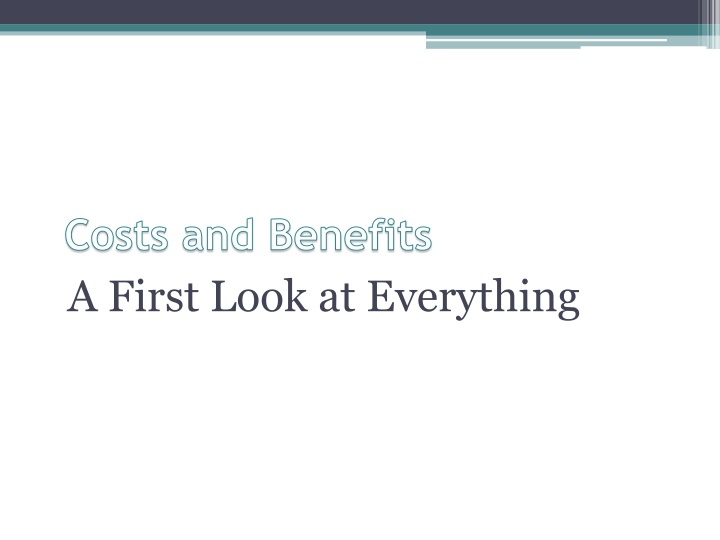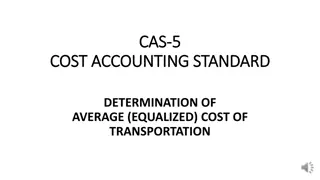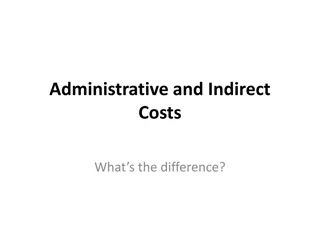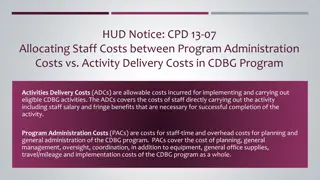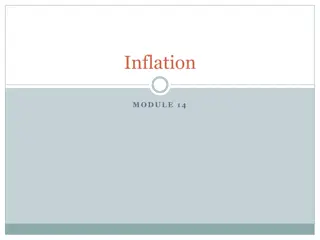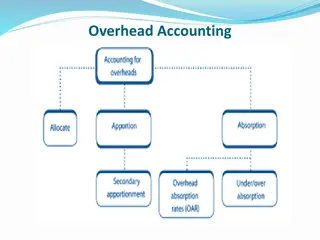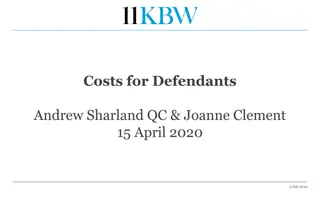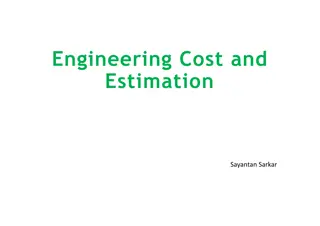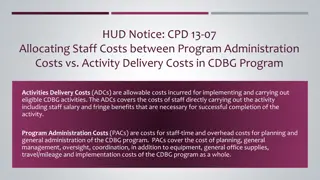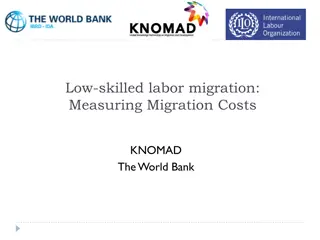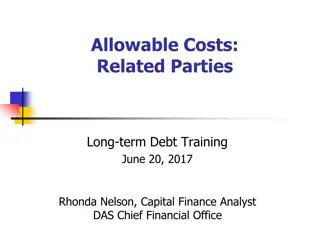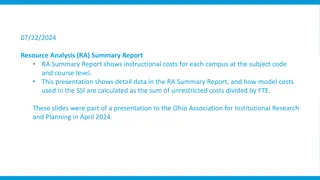Costs and Benefits: A First Look at Everything
Concept of time value of money, interest rates, and the impact of delays in financial decisions. Analyze real investment opportunities and understand the cost implications of delaying projects.
Download Presentation

Please find below an Image/Link to download the presentation.
The content on the website is provided AS IS for your information and personal use only. It may not be sold, licensed, or shared on other websites without obtaining consent from the author.If you encounter any issues during the download, it is possible that the publisher has removed the file from their server.
You are allowed to download the files provided on this website for personal or commercial use, subject to the condition that they are used lawfully. All files are the property of their respective owners.
The content on the website is provided AS IS for your information and personal use only. It may not be sold, licensed, or shared on other websites without obtaining consent from the author.
E N D
Presentation Transcript
Costs and Benefits A First Look at Everything
The Time Value of Money and Interest Rates Time Value of Money Imagine a simple real investment opportunity with the following cash flows (which are certain to occur). Cost: $1,000 today Benefit: $1,030 in one year Can we judge the opportunity as valuable by noting that $1,o3o > $1,000? Money has two units The difference in value between money today and money in the future is the time value of money.
The Interest Rate: An Exchange Rate Across Time The rate at which we can exchange money today for money in the future via the financial markets is determined by the current interest rate. Suppose the current annual risk free interest rate is 5%. By investing or borrowing at this rate, we can exchange (trade) $1.05 in one year for $1 today. Risk Free Interest Rate (Discount Rate), rf: The interest rate at which money can be borrowed or lent without risk. Interest Rate Factor = 1 + rf= 1.05 ($s tomorrow/$ today) Discount Factor = 1 / (1 + rf) = 1/1.05 = $0.9524 ($s today/$ tomorrow) Investors are compensated for surrendering capital.
Previous Example Our Real investment opportunity Cost: $1,000 today Benefit: $1,030 in one year $1,000 today becomes $1,030 in one year. Financial market, with an interest rate of 5%: $1,000 (1+rf) = $1,000 (1.05) = $1,050 $1,000 today becomes $1,050 in one year. What do we think of the investment opportunity?
Problem The cost of replacing a fleet of company trucks with more energy efficient vehicles is $100 million now. The cost is estimated to rise by $8.5 million next year. If the interest rate is 4%, what is the cost of a delay in terms of dollars next year?
Solution If the project were delayed, it s cost next year will be: $100 million +$8.5 million = $108.5 million next year Compare this amount to the cost of replacing now, stated in dollars next year using the interest rate of 4%: $100 million ($1.04 next year/$1 now) = $104 million next year The cost of a one year delay would be: $108.5 million $104 million = $4.5 million next year (future value)
Problem The cost of replacing a fleet of company trucks with more energy efficient vehicles is $100 million now. The cost is estimated to rise by $8.5 million next year. If the interest rate is 4%, what is the cost of a delay in terms of dollars now?
Solution We know if we delay, the project costs $108.5 million next year. Compare this amount to the cost of $100 million now using the interest rate of 4%: $108.5 million ($1.04 next year/$1 today) = $104.33 million today The cost of a one year delay would be: $104.33 million $100 million = $4.33 million today (present value). A different value?
Discussion This example is the same as the example of trading gold for silver presented in the text. The price today of receiving $1.04 in one year is $1. The price today of receiving $1 today is of course $1. After we convert the values using these prices we do not ask whether to trade $X today for $Y in one year but rather should we trade $X today for $W today. Important: the $Y in one year and the $W today are equivalent. In these terms the choice is clear: is X W or X W? We will discuss and extend this idea as we go forward.
Present Value and the NPV Rule The net present value (NPV) of a project or investment is the difference between the present value of its benefits and the present value of its costs. Net Present Value = = (Benefits) (Costs) (Benefits Costs) NPV PV PV PV = (incremental project cash flows) NPV PV
The NPV Decision Rule When making an investment decision, take the alternative with the highest NPV. Choosing this alternative is equivalent to receiving its NPV in cash today. Accept all projects with a positive NPV. Accepting them is equivalent to receiving their NPV in cash today (firm value changes by the NPV of the project). Reject projects with a negative NPV. Accepting these projects is equivalent to reducing current wealth by their NPV.
Consider Three Projects (rf= 20%) Project A B C Cash Today ($) 42 -20 -100 Cash in one year ($) 42 144 225 Project Cash Today PV of Cash in one year NPV ($ today) A 42 B -20 C -100
Consider Three Projects (rf= 20%) Project A B C Cash Today ($) 42 -20 -100 Cash in one year ($) 42 144 225 Project Cash Today PV of Cash in one year 42 1.20 = 35 NPV ($ today) A 42 42 + 35 = 77 B -20 144 1.20 = 120 -20 + 120 = 100 C -100 225 1.20 = 187.5 -100 + 187.5 = 87.5
NPV Although Project B has the highest NPV, what if we do not want to (can t) spend the $20 for the cash outlay? Would Project A be a better choice? Should this affect our choice of projects? What if you will need more than $144 next year, is Project C then a good choice? As long as we are able to borrow and lend at today s interest rate, Project B is superior whatever our preferences regarding the timing of the cash flows. Again, this follows from the same logic as the gold for silver trade in your text. Let s see
NPV and Individual Preferences Project B and borrowing Cash today Cash in one year Project B -20 144 Borrow 62 -62 1.20 = -74.4 Total 42 (compare A: 42) 69.6 (compare A: 42) Project B and saving Cash today Cash in one year Project B Save Total -20 -80 -100 (compare C: -100) 144 80 1.20 = 96 240 (compare C: 225)
NPV and Individual Preferences Project B and borrowing Cash today Cash in one year Project B -20 144 Borrow 120 -144 Total 100 0 As we said, accepting a positive NPV project is equivalent to receiving that much cash today. This arrangement is equivalent to selling the right to project B and extracting all the value in the sale.
Separation Principle The only arbitrage free price for a financial security is for price to equal the present value of the cash flows (expected to be) paid by that security. This means that in an arbitrage free market the NPV of buying or selling financial securities is zero. Every trade has a buyer and a seller, if the price is such that the NPV is not zero one party will object. Therefore, a real investment project can be evaluated independently of the financing necessary to pursue it.
